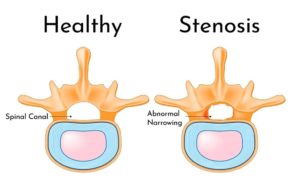Spinal Laminectomy
What is a Laminectomy?
A Laminectomy surgery creates space by removing the lamina — the back part of the vertebra that covers your spinal canal. Also known as decompression surgery, laminectomy enlarges your spinal canal to relieve pressure on the spinal cord or nerves.
When Decompressive Laminectomy is Necessary
Laminectomy is generally used only when more-conservative treatments — such as medication, physical therapy or epidural injections — have failed to relieve symptoms. Laminectomy may also be recommended if symptoms are severe or worsening dramatically.
Member of the American Association of Neurosurgery

Cervical Laminectomy
A cervical laminectomy is performed for certain patients with cervical spinal stenosis, which is a narrowing of the spinal canal in the cervical area (the neck). Stenosis may be caused by a number of degenerative spine conditions, including wear and tear on the bones, discs, and ligaments. A narrow spinal canal can compress (pinch) the spinal cord and surrounding nerves. Compression may irritate a spinal nerve or nerves, causing radiculopathy (pain, weakness, numbness or tingling in one limb). Compression of the spinal cord itself can damage its delicate tissues and cause myelopathy (pain, weakness, numbness or tingling in both arms or legs, difficulty walking, and/or loss of bowel or bladder control).
Cervical Spinal Stenosis Surgery
A laminectomy decompresses (removes the pressure from) the spinal cord and spinal nerves. It is generally effective when performed in patients who have an identifiable compression resulting in radiculopathy or myelopathy.

Before surgery is considered, non-operative measures like physical therapy and pain medications may be tried. These measures provide effective relief in many cases. But when other treatment plans do not provide relief, and a problem exists that can be surgically corrected, surgery is often the treatment of choice. Surgery is also typically required for cases in which the spinal cord is compressed.
Lumbar Laminectomy Surgery
Lumbar laminectomy is similar to a cervical laminectomy, just adjusted for the lumbar area of the spine. The lumbar part of the spine is the lower back, and the symptoms of lumbar stenosis affect the legs and can cause decreased mobility and weakness in one or both legs. The goal of the laminectomy will be to decrease pressure on the nerves and reduce leg pain while improving leg functionality if affected.
Laminotomy vs Laminectomy
These two surgeries have a similarity in that they both operate on your spine’s lamina, where they get their names. The laminectomy is the complete removal of the lamina, the laminotomy only removes a piece of that lamina. The reason for the surgeries are also similar, in that they aim to decompress a nerve causing back pain or other nerve related symptoms. The lamina may be removed because it is causing the compression of your nerve, or it may need to be partially removed to gain access to the parts of the spine that are causing the nerve compression.
Laminectomy with Fusion
Laminectomy is sometimes performed with fusion in case of instability of the spine. Spinal fusion involves taking a bone graft from your pelvis or spine and securing it between two or more unstable vertebrae to cause the two vertebrae to fuse together over time. This involves screws, rods, and metal plates to secure the bone graft in place and increase spinal stability.
Success Rates of Laminectomy for Spinal Stenosis
Laminectomy has a fairly good result when treating spinal stenosis. Between 85% and 90% of patients who are suffering from lumbar spinal stenosis find relief from leg pain and numbness after having a laminectomy procedure. The healing effects last up to 10 years in 75% of these patients. Though there are risks that may be cause for surgical failure such as smoking, or improper recovery after the surgery.
How soon after a laminectomy can I exercise?
Exercising can be strenuous on your back, and for the area where your laminectomy was performed, so it’s typical to avoid heavy lifting, bending, or exercising for 2-3 months. If you had additional surgeries with a laminectomy, such as a spinal fusion, you may wait up to 4 months during the recovery period. Light walking and guided physical therapy when you’re ready as advised by your doctor can help speed up the recovery time frame.
More about Laminectomy Recovery
You should try to avoid biking, jogging, and weight lifting until you’re cleared by your doctor. You should also avoid driving for a few weeks, and sitting in a car for more than 30 minutes at a time, and if you do, be sure to take a break to walk as to avoid excess strain on your back. It’s important to get enough sleep while healing, since it will aid in your recovery process. You can use heating pads on low or a warm cloth to help with back soreness if needed, but be sure not to fall asleep with the heating pad on your skin.
Life after Cervical Laminectomy Surgery
Pain levels 4 years after the laminectomy was performed generally saw improvements between 50% and 80% based on the pre-surgery pain levels and the scope of the operations performed. Medication usage also goes down since the pain management isn’t as prominent in the patient’s daily life. There is also significant functional improvements in things like walking, sitting, and physical activities. Also, up to 80% of people are still working 4 years after a laminectomy due to arthritis.


